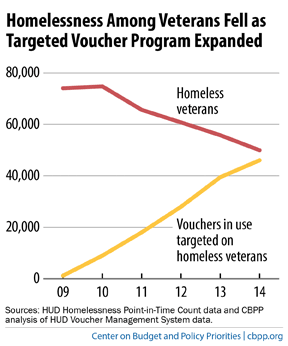BEYOND THE NUMBERS
One cause for celebration this Veterans’ Day is the impressive recent progress in reducing homelessness among veterans described in our updated paper. The number of homeless veterans has dropped by 33 percent since 2010, the Department of Housing and Urban Development (HUD) finds. That still leaves roughly 50,000 veterans without homes on any single night, so we still have work to do. But we’re moving in the right direction.
What’s behind these gains? While it’s difficult to isolate factors like the recovering economy or recent anti-homelessness initiatives, a large share of the credit likely goes to the HUD-Veterans Affairs Supportive Housing (HUD-VASH) voucher program, which provides rental assistance to homeless veterans in combination with case management and clinical services through VA medical centers.

Policymakers should build on this progress by funding more HUD-VASH vouchers or other rental assistance for veterans. And they should restore recent cuts to broader rental assistance programs that help many veterans as well as other low-income people.
The encouraging decline in veteran homelessness also suggests that we could make similar progress against homelessness among other groups by targeting new vouchers on them. Currently, fewer than one in four households eligible for rental assistance receive it due to funding limitations.
For example, 1.2 million school-age children were homeless during the 2012-2013 school year, Department of Education data show, including 940,000 whose families had to double up with other families and 300,000 living in shelters, hotels, or on the streets. If Congress funded new vouchers for homeless or at-risk children and their families, we would likely see sharp declines over time in those figures as well.
